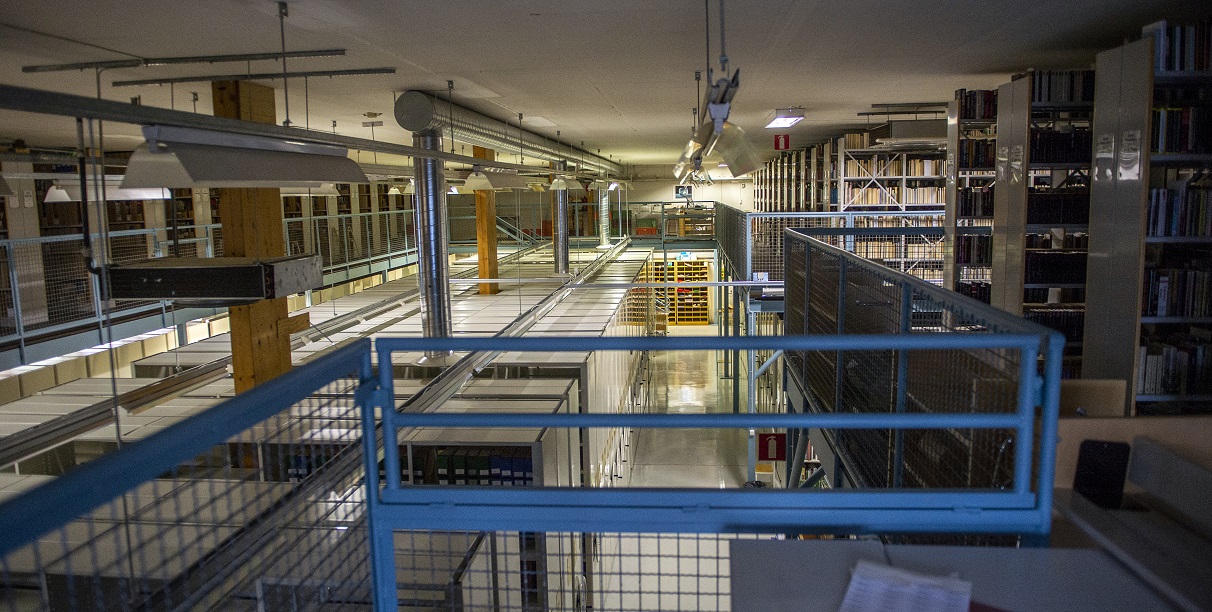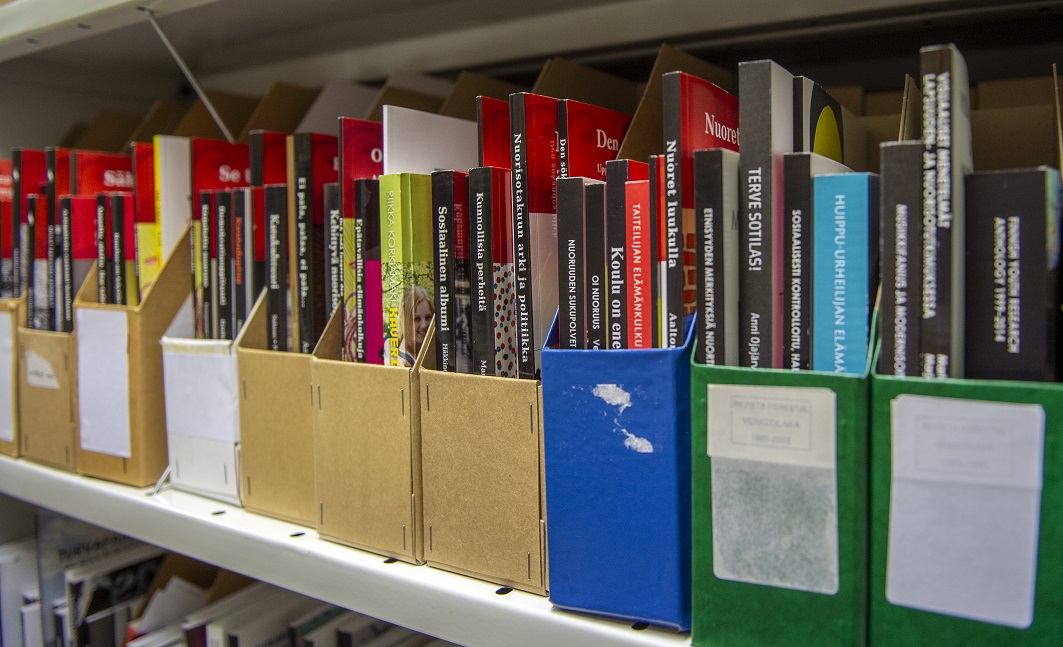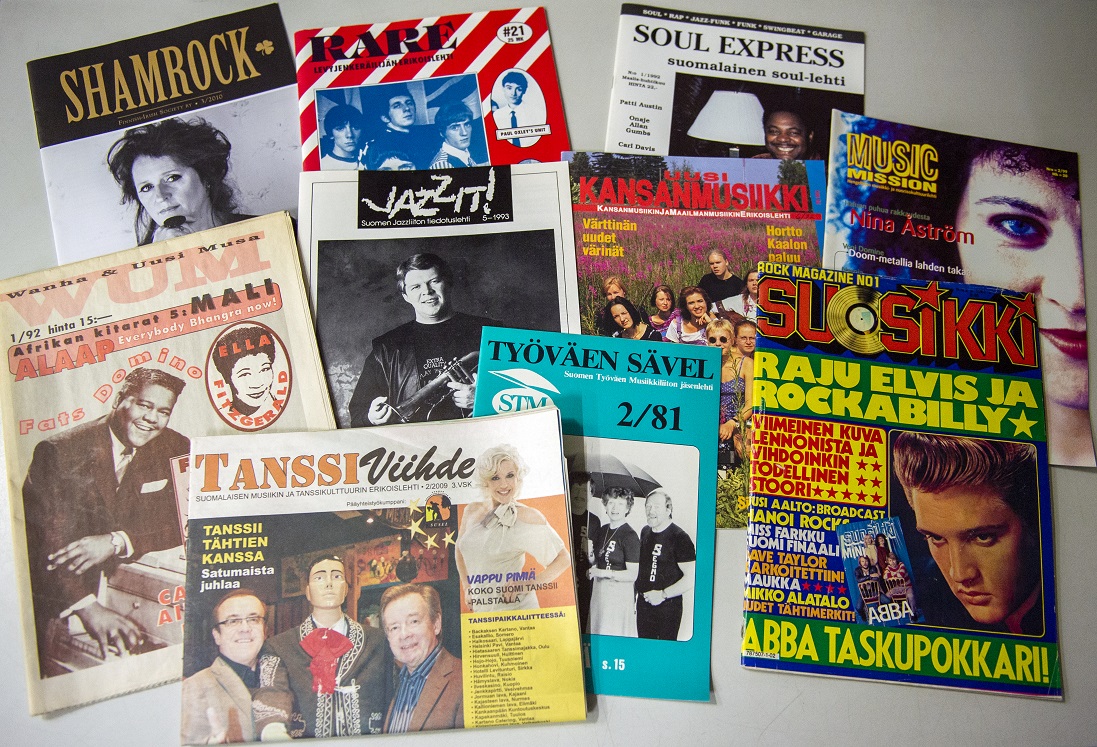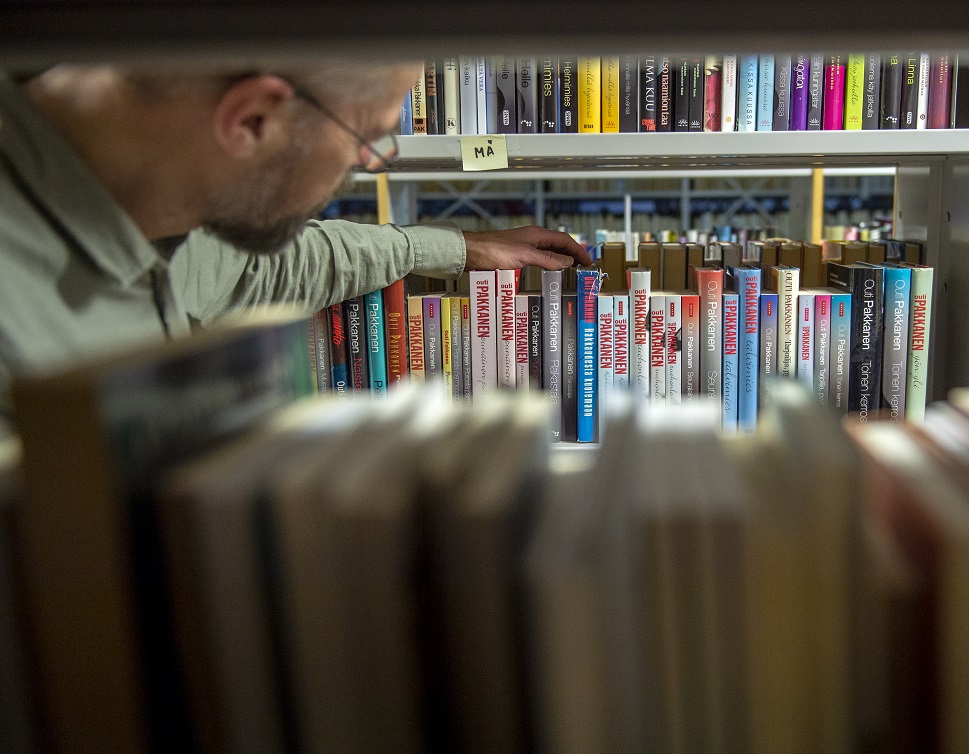Kulttuuriaineistot käyttöön: kirjaston painetut vapaakappaleet | Start using cultural materials: the library’s printed legal deposit copies
(Please, scroll down to read in English.)
Vapaakappalekokoelma on lakisääteisesti karttuva kotimaisten painettujen ja sähköisten aineistojen kokoelma. Lakitekstin mukaan ”tarkoituksena on Suomessa yleisön saataville saatettujen kansallisen kulttuurin aineistojen säilyttäminen tuleville sukupolville ja saattaminen tutkijoiden ja muiden tarvitsijoiden käyttöön”. Painotuotteiden osalta julkaisijat ja valmistajat ovat velvollisia luovuttamaan kappaleet valmistamistaan tuotteista Kansalliskirjastoon. Sieltä ne sijoitetaan säilytettäväksi ja käytettäväksi kuuteen eri puolilla maata sijaitsevaan yliopistokirjastoon, joista Itä-Suomen yliopiston kirjasto on yksi. Fyysisesti aineistot sijaitsevat Joensuussa.
Säilytys
Suomessa vapaakappaletoiminnan historia ulottuu Ruotsin vallan aikaan. Turun Akatemia sai virallisen vapaakappaleoikeuden vuonna 1707. Turun palon jälkeen yliopisto ja sen myötä vapaakappaleoikeus siirrettiin Helsinkiin. Nykymuotoinen vapaakappaletoiminta käynnistyi vuonna 1919. Vapaakappaleiden vastaanottajaksi tuli Helsingin yliopiston kirjasto ja vapaakappaleoikeus laajeni Turkuun, Jyväskylään, Viipuriin ja myöhemmin Ouluun. Ajatuksena oli palvelun ulottaminen maakuntiin ja varakokoelmien luominen mahdollisten katastrofien varalta. Ääni- ja kuvatallenteet tulivat lain piiriin vuonna 1980 ja e-aineistot, verkkoaineistot ja TV- ja radio-ohjelmat vuonna 2008. Tällä hetkellä vapaakappaleoikeus on Kansalliskirjastolla ja Itä-Suomen, Jyväskylän, Oulun, Turun ja Åbo Akademin yliopistokirjastoilla. Joensuun korkeakoulun kirjasto sai vapaakappaleoikeuden vuonna 1980. Oikeus oli aluksi jaettu Eduskunnan kirjaston kanssa. Täysi vapaakappaleoikeus saatiin Joensuuhun vuonna 2008.
Painettuja aineistoja kokoelma sisältää vuodesta 1981 lähtien: kirjoja, aikakauslehtiä, nuotteja ja karttoja. Sanomalehtien ja pienpainatteiden osalta luovutusten lakisääteiset kappalemäärät ovat muita painotuotteita pienempiä eikä niitä säilytetä Itä-Suomen yliopiston kirjaston kokoelmassa. Ei myöskään fyysisiä äänitteitä, tallenteita tai pelejä.

Vapaakappaleyksikön varastotiloissa on lähes kolmetoista kilometriä hyllytilaa. | The storage for legal deposit copies contains almost 13 kilometres of shelves.
Kaikkea Suomessa julkaistua ei kokoelmasta löydy. Tähän on kolme syytä. Julkaisijat ja valmistajat eivät ole luovuttaneet lain edellyttämiä kappaleita tai niitä on luovutettu vähemmän kuin pitäisi. Kansalliskirjaston resurssit kontrolloida luovutuksia ovat tässä suhteessa rajalliset. Vuosina 1981-2007 vapaakappaleoikeus oli jaettu: Eduskunnan kirjasto otti ensin haluamansa aineistot ja loput sijoitettiin Joensuuhun. Lisäksi kokoelmia ei puuttuvien aineistojen osalta ole juurikaan täydennetty.
Rajoituksineenkin kokoelma on suuri sekä kooltaan että merkitykseltään. 42 vuoden aikana aineistoa on kertynyt lähes 800 000 kappaletta ja noin kahdeksan ja puoli hyllykilometriä. UEF-Primoon kuvailluista painetuista nimekkeistä vapaakappaleita on noin 20 %. Kotimaisen aineiston osalta vapaakappaleet lisäävät merkittävästi kirjaston kokoelmien kattavuutta.
Käyttö
Vapaakappaleiden käyttöä ei ole rajattu yliopistoyhteisön jäseniin. Vapaakappaleita voivat käyttää kirjaston tiloissa kaikki tietoa tarvitsevat. Painettujen vapaakappaleiden käyttö edellyttää kuitenkin rekisteröitymistä kirjaston asiakkaaksi. Aineisto lainataan asiakkaalle lukusalikäyttöön, niitä ei saa kotilainaksi. Lain ensisijainen tarkoitus on säilyttävä. Itä-Suomen yliopiston kirjastossa aineiston säilyminen on haluttu varmistaa siten, että aineistoja voi käyttää vain kirjaston tiloissa. Poikkeuksena ovat yliopiston henkilökuntaan kuuluvat, jotka saavat aineistot työhuonekäyttöön.
Kokoelman kaikkia aineistoja ei alun perin luetteloitu kirjaston tietokantaan. Asiakkaan kannalta se vaikeutti aineiston löytämistä ja rajoitti siten vapaakappaleiden käyttöä. Vuodesta 2016 lähtien aineiston käyttöön saamista on helpotettu lataamalla tietueita kirjaston tietokantaan Melinda-metatietovarannosta taannehtivasti puolivuosittain. Rajavuodeksi valittiin 2008, jolloin kirjasto sai täyden vapaakappaleoikeuden myötä kattavamman kertymän. UEF-Primosta löytyvät tietokirjat ja sarjat vuodesta 2008 lähtien sekä osa vuosina 1981-2007 julkaistusta aineistosta. Pääosaa vanhemmasta aineistosta ei ole luetteloitu tietokantaan. UEF-Primosta valtaosin puuttuvia aineistoja ovat kaunokirjallisuus, lasten- ja nuortenkirjat, sarjakuva-albumit, vuosijulkaisut, virallisjulkaisut, tilastot, aikakauslehdet, nuotit ja kartat. Niiden osalta aineistotietoja voi hakea verkon yhteistietokannoista, kuten Melinda-, Finna- ja Kansalliskirjaston Finna -tietokannoista. Kokoelmaan säännöllisesti tulevista ja tulleista aikakauslehdistä on erillinen luettelo.

Nuorisotutkimuksen sarjajulkaisujen aikasarjoja. | Periods of serial publications of youth research.
Aineiston saa käyttöönsä tekemällä siihen vapaakappalepyynnön. Koska kaikkea aineistoa ei ole luetteloitu tietokantaan, pyynnön tekemiseen on kaksi tapaa. UEF-Primosta löytyvää aineistoa varten ei enää tarvitse täyttää verkkolomaketta, vaan ne voi tilata tekemällä vapaakappalepyynnön suoraan UEF-Primossa. Koska vapaakappaleet ovat erikoiskokoelma, varausta ja vapaakappalepyyntöä ei pidä sekoittaa keskenään. Jos haluaa normaalin lainakappaleen, valitaan varaus, jos haluaa vapaakappaleen, valitaan vapaakappalepyyntö. UEF-Primosta puuttuvia aineistoja pyydetään edelleen verkkolomakkeella.
Aina aineisto ei ole vapaakappalekokoelmassa, vaikka se UEF-Primon mukaan on ”saatavilla” ja ”tilattavissa lukusalikäyttöön”. Kun aineiston tietueita ladataan Melindasta UEF-Primoon, hyllystä ei voida tarkistaa, ovatko kaikki aineistot tosiasiallisesti saatu kokoelmaan. Jos asiakkaiden pyynnön yhteydessä ilmenee, että aineistoa ei kokoelmassa ole, pyyntö perutaan ja tietueet poistetaan. Asiakkaan on varmasti vaikea hahmottaa tätä. Toisaalta haussa löytyvät vapaakappaleet ovat kotimaisen aineiston osalta valtava lisäresurssi. Helposti saavutettavissa on paljon aineistoa, jota kirjaston olisi mahdoton muuten hankkia.
Vapaakappaleaineistot ovat Joensuussa, mutta niitä ei säilytetä kampuskirjastolla vaan erillisissä tiloissa teollisuusalueella. Tämän vuoksi aineistoa ei saa välittömästi käyttöön – edes Joensuussa. Aineiston toimitusaika on kahdesta seitsemään vuorokautta postin toiminnasta riippuen. Normaalisti aineistot toimitetaan muutamissa päivissä, myös Kuopion kampukselle. Asiakas saa saapumisilmoituksen sähköpostiinsa, kun aineisto on käytettävissä kirjastossa. Se on lainattava kirjaston palvelutiskillä seitsemän vuorokauden kuluessa ilmoituksen lähetyksestä. Lainattua aineistoa säilytetään asiakaspalvelussa, josta sen saa pyytämällä käyttöönsä.
Lisätietoa Itä-Suomen yliopiston vapaakappalekäytännöistä.

Aku Ankan taskukirjat ovat lastenlehtihyllyjen kaunistus. | Donald Duck pocket books embellish the shelves of children’s magazines.
The legal deposit collection is a collection of Finnish printed and electronic materials that is collected according to legislation. According to the legal text, “the aim is to preserve the national cultural material made available to the public in Finland for future generations and make it available to use by researchers and other people in need”. Regarding printed products, publishers and manufacturers are obliged to hand over copies of the products they manufacture to the National Library of Finland. From there, they are sent for storage and use in six university libraries around the country, one of which is the University of Eastern Finland Library. Physically, the materials are located in Joensuu.
Storage
In Finland, the story of legal deposit activities begins in the time under Swedish rule. In 1707, the Academy of Turku was granted an official right to legal deposit. After the great fire of Turku, the university and, as a result, the right to legal deposit was transferred to Helsinki. Legal deposit activities began in their current form in 1919. The recipient of the legal deposit copies was the Helsinki University Library, and the right to legal deposit was expanded to apply to Turku, Jyväskylä, Vyborg and later to Oulu. The idea was to extend the service to counties and create backup collections in case of disasters. Audio and video recordings were included in the legal text in 1980, and electronic materials, online materials and TV and radio programmes were included in 2008. At the moment, the National Library of Finland and the university libraries of Eastern Finland, Jyväskylä, Oulu, Turku and Åbo Akademi University have the right to legal deposit. The library of the former Joensuu University was granted the right to legal deposit in 1980. The right was initially shared with the Library of Parliament. A full right to legal deposit was granted to Joensuu in 2008.
The collection of printed materials contains material since 1981: books, magazines, sheet music and maps. Regarding newspapers and small print media, the statutory number of copies is smaller than that of other printed products and they are not stored in the collection of the University of Eastern Finland Library. There are no physical audio recordings, other recordings or games either.
Not everything published in Finland can be found in the collection. There are three reasons for this. Publishers and manufacturers have not delivered the copies required by law or have delivered fewer of them than they should. The National Library’s resources for controlling deliveries are limited in this respect. Between 1981 and 2007, the right to legal deposit was shared: the Library of Parliament first took the material they wanted, and the rest were sent to Joensuu. Additionally, the collection has hardly been supplemented with missing material.
Even within these limitations, the collection is large in size and significance. After 42 years, the collection contains nearly 800,000 copies and approximately eight and a half shelf kilometres. About 20% of the printed titles catalogued to UEF Primo are legal deposit copies. For domestic material, legal deposit copies significantly increase the extensiveness of the library collections.
Use
The use of legal deposit copies is not restricted to members of the university community. Legal deposit copies can be used in the library’s facilities by anyone in need of information. However, the use of printed legal deposit copies requires registration as a library customer. The material is lent to the customer for reading room use; they cannot be loaned to take home. The primary purpose of the Act is preservation. In the University of Eastern Finland Library, we ensure the preservation of the materials by only allowing their use in the premises of the library. This does not apply to university staff that get to use the materials in their office.
Not all materials in the collection were originally listed in the library database. From the customer’s point of view, it made it difficult to find the material and thus restricted the use of legal deposit copies. Since 2016, access to the material has been facilitated by uploading records retroactively to the library database from the Melinda metadata repository every six months. The cut-off was set as 2008 when the library received a more comprehensive accumulation because of the full right to legal deposit. UEF Primo contains non-fiction books and series from 2008 and some of the material published between 1981 and 2007. Most of the older material is not listed in the database. The materials that are mostly missing from UEF Primo include fiction, children’s and young adult books, comic book albums, annual publications, official publications, statistics, magazines, sheet music and maps. For these, material information can be retrieved from shared online databases, such as the Melinda, Finna and the National Library of Finland’s Finna databases. There is a separate list of periodical magazines that are regularly included in the collection.

Suomalainen musiikkilehdistö on laaja ja kirjava. | Finnish music press is colourful and wide-ranging.
You can access the material by making a legal deposit copy request. Since not all materials are listed in the database, there are two ways to make a request. You no longer need to fill in an online form for the material found in UEF Primo. Instead, you can order it by submitting a legal deposit copy request directly in UEF Primo. Since legal deposit copies are a special collection, a request and a legal deposit copy request should not be confused. If you want to loan a normal copy, you select a request. If you want a legal deposit copy, select a legal deposit copy request. You must still request materials that are not in UEF Primo by filling in an online form.
The material is not always in the legal deposit copy collection even if it is “available” and “for reading room use upon request” according to UEF Primo. When uploading resource records from Melinda to UEF Primo, it is not possible to check on the shelf whether all resources have actually been received in the collection. If a customer request reveals that a resource does not exist in the collection, the request is cancelled, and related records are deleted. This might be difficult for the customer to understand. On the other hand, the legal deposit copies found via searching are an enormous additional resource for domestic material. There is a lot of easily accessible material that would otherwise be impossible to obtain by the library.
The legal deposit material is located in Joensuu, but it is not stored in the campus library but in separate premises in an industrial area. For this reason, the material cannot be used immediately – even in Joensuu. The delivery time of the material is between two and seven days, depending on the post services. Normally, the material will be delivered within a few days, including to the Kuopio campus. The customer receives an arrival notification by e-mail when the material is available at the library. It must be borrowed at the library’s service desk within seven days after the notification was sent. The borrowed material will be stored at customer service, from where it can be obtained upon request.
More information on the University of Eastern Finland’s legal deposit copy practices.
Jouni Mielonen, tietopalveluneuvoja | Information services advisor
Tietoaineistopalvelut | Collection services
Kuvat | Photos: Varpu Heiskanen

